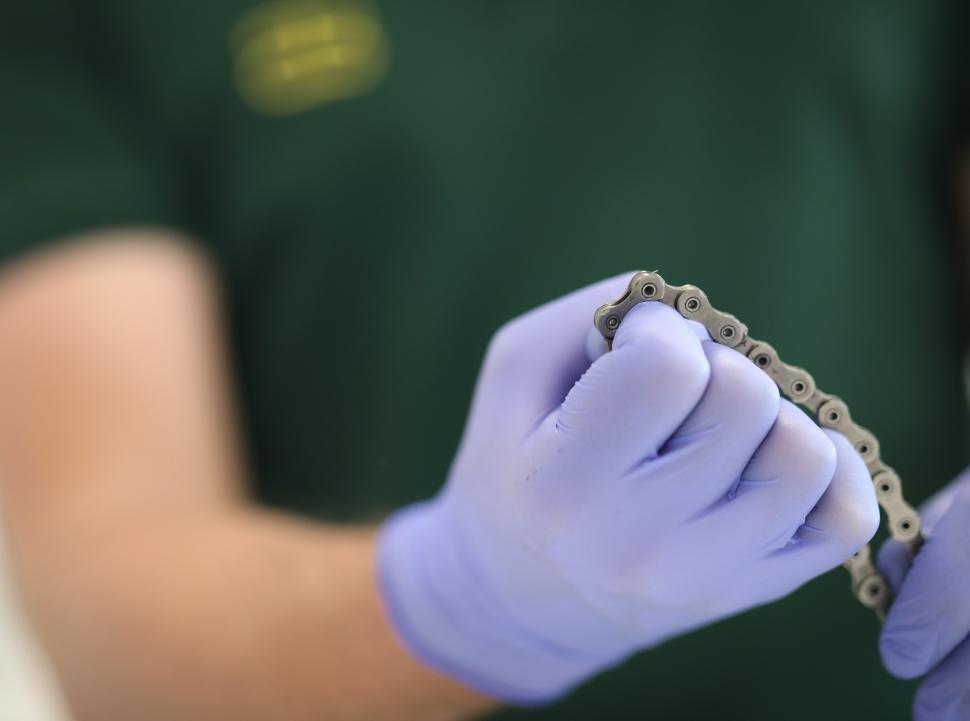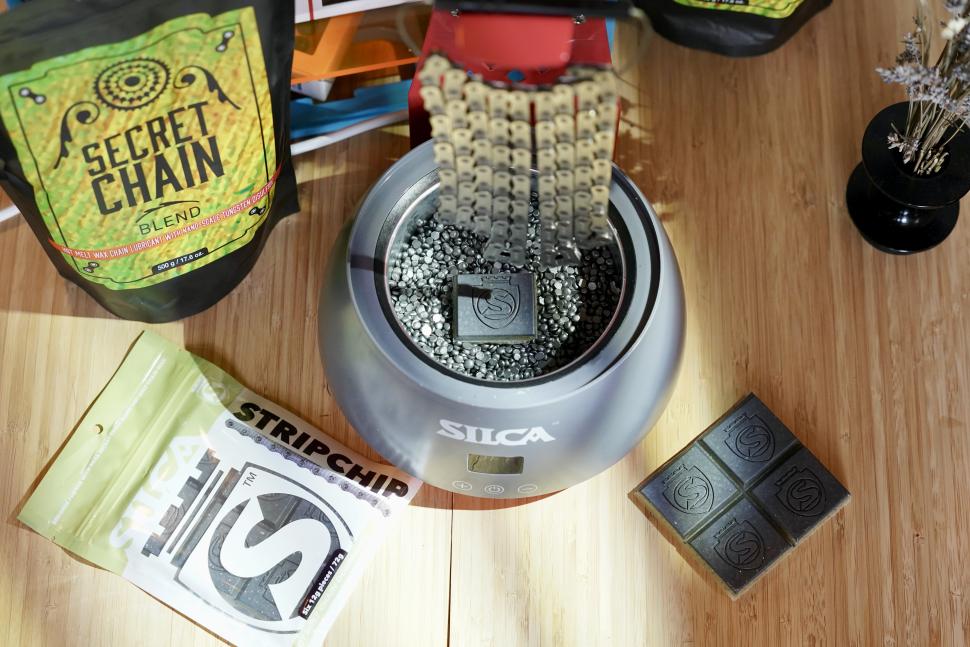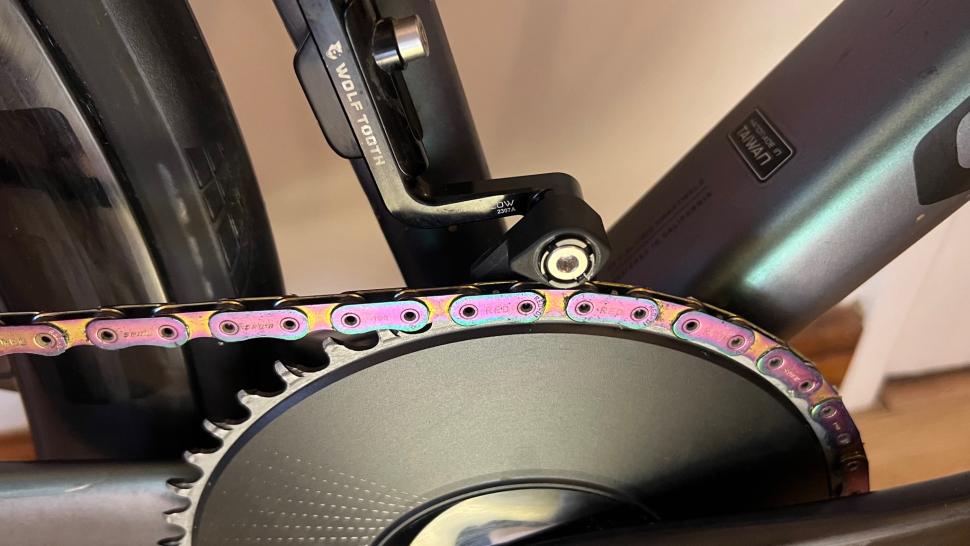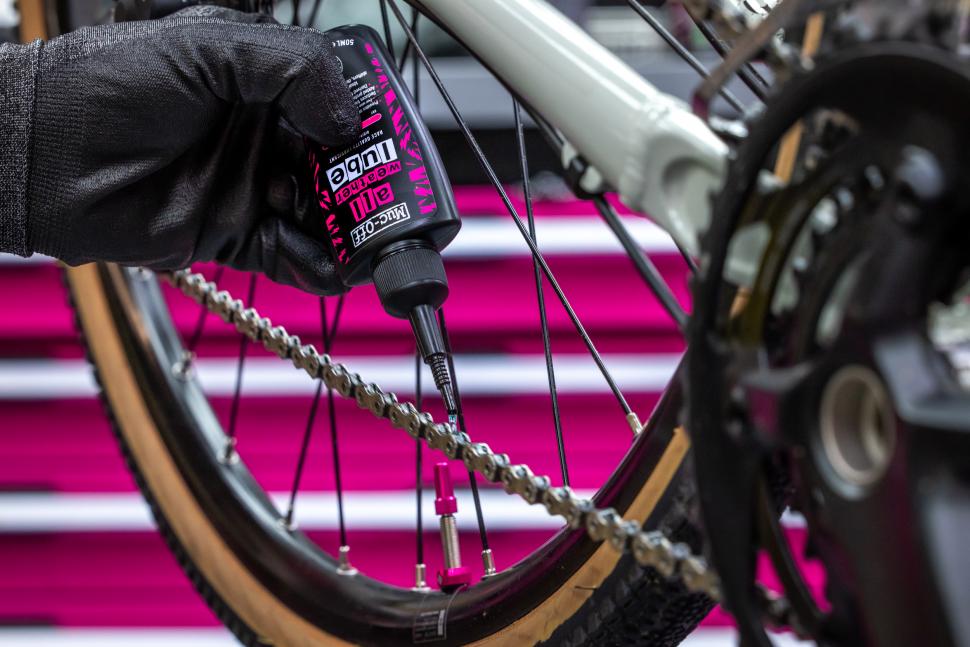- News
- Reviews
- Bikes
- Components
- Bar tape & grips
- Bottom brackets
- Brake & gear cables
- Brake & STI levers
- Brake pads & spares
- Brakes
- Cassettes & freewheels
- Chains
- Chainsets & chainrings
- Derailleurs - front
- Derailleurs - rear
- Forks
- Gear levers & shifters
- Groupsets
- Handlebars & extensions
- Headsets
- Hubs
- Inner tubes
- Pedals
- Quick releases & skewers
- Saddles
- Seatposts
- Stems
- Wheels
- Tyres
- Tubeless valves
- Accessories
- Accessories - misc
- Computer mounts
- Bags
- Bar ends
- Bike bags & cases
- Bottle cages
- Bottles
- Cameras
- Car racks
- Child seats
- Computers
- Glasses
- GPS units
- Helmets
- Lights - front
- Lights - rear
- Lights - sets
- Locks
- Mirrors
- Mudguards
- Racks
- Pumps & CO2 inflators
- Puncture kits
- Reflectives
- Smart watches
- Stands and racks
- Trailers
- Clothing
- Health, fitness and nutrition
- Tools and workshop
- Miscellaneous
- Buyers Guides
- Features
- Forum
- Recommends
- Podcast
feature
 Chain Waxing April 2024
Chain Waxing April 2024Your complete guide to waxing your chain: how to save watts and keep your chain clean for longer
Chain waxing has had a lot of press recently, with new products being launched into the market, and claims saying it's the best way of maintaining your drivetrain. Yet, while some swear by it, others would rather never hear another word about how great it is to dip your chains in melted wax. If it's true that chain waxing offers saved watts, free speed, and a clean drivetrain, why isn't everyone doing it? We've been investigating everything you need to know about chain waxing, including the benefits and how to get started.
Although it has really got more popular recently, Henry Krause, who founded Finish Line in 1988, says that people have been waxing their chains for a lot longer than you might imagine. That said, nearly four decades ago, the process of waxing a chain was much more complicated than it is now.
"There was a subset of people that were chain waxing," says Krause. "It was for them not an easy process because master links [quick-release chain links] didn't exist, so you had to have the competence and the expertise to be able to take your chain off the bike, and then put it back on, which might have been a more difficult challenge.
"But back then, people would get candle wax [paraffin], they would melt it down, put their chain in it, wax the chain, and then put it back on. It was a very small niche of people, but clearly it existed.
"From there, in the early to mid-90s, there was a company called White Lightning [it still exists] that invented a way of applying wax through the direct method, squirted out of a bottle. They did become very, very popular lubricants. They have patents on that technology and pretty much owned it until recent years, when people found they could get around the patents by emulsifying wax into water," Krause explains.
The first versions of chain waxes were not quite the engineered, scientific mixtures we are seeing today, and the benefits of waxing became even more pronounced with the possibility of immersion waxing.
"Now there was a method of dripping it on in a water solution with other additives. That provided all sorts of benefits that are associated with wax. And now, with the master link being tied to virtually all bikes, the option of hot dip waxing is in play and becoming popular," Krause says.
What are the benefits of chain waxing?
The primary appeal of chain waxing lies in its ability to address common issues associated with traditional lubes, such as messiness and the need for frequent reapplication. By keeping the chain dry and clean, waxing has the potential to improve drivetrain efficiency and longevity. The advantages cover all types of cycling, although some say waxing offers the greatest benefit for messier off-road gravel and mountain bike rides.
Reducing drivetrain friction minimises energy loss and also prevents premature wear. There are various watt-saving claims associated with chain waxing.
"The best chain treatment ever tested is the Secret Chain Blend Wax," Silca claims. "This can save 6-8 watts over some of the lower-end chain lubes out there."
Silca doesn't specify in what circumstances this is true: the gear combo you're using or the speed at which you're riding.
Silca continues: "If you aren’t up for the application process of hot wax, Silca's Synergetic Chain Lube is the fastest oil-based option that has been tested. That can still save 4-6W over some of the other options out there. Having a clean chain and the best lubricant choice can save about 12W."
Even if you don't prioritise speed, barely any of us turn up our noses at saving hard-earned money. The increased friction that is measured on the chain using standard lubes is what causes your drivetrain to wear down and, hence, costs more money.
The increased longevity of your drivetrain also increases sustainability in some way, as this means you need to replace parts less, leading to lower consumption – although some chain waxes also continue to use PTFEs or other forever chemicals.
While traditional chain lubes can somewhat effectively coat your chain in an oil-based substance that keeps things rolling relatively smoothly, they aren't the best option for reducing friction and can wear out much more rapidly than a wax-based product. Oil-based lubes can be great at keeping your drivetrain quiet, but they attract a lot of other things you don't want on your chain.
"The oil has the downside of potentially being a magnet for attracting those abrasive contaminants which can undermine lubrication and create premature abrasive wear," Finish Line's Krauser explains. "It's a balancing act. When we have a heightened concern around the potential for contamination, we lean to wax or a dry-style lubrication.
"In the extremes, wax - if it's properly formulated - will be bone dry to the touch and therefore will not absorb and attract abrasive contaminants. The most important advantage of wax is its ability to uniquely keep the chain clean."
Pure wax and pure olive oil (which you could use on your chain if you wanted) do not adhere to the chain metal very well, either. This is why there are additives in lubes, and why immersion waxed chains works so well from an efficiency standpoint. Bike chain wax solidifies, doesn’t gunk up with dirt, and should remain cleaner to the touch.
There is a lot more science to drivetrain efficiency, and the very aptly named Zero Friction Cycling (ZFC) is perhaps the most well-known expert and tester in the field of chain lubes and waxing.
ZFC has produced a whole host of data on the effects of how lubing (or not) and maintenance can be the make-or-break difference between having a worn chain after just a couple thousand kilometres or happily spinning on the same chain for 15,000km. Silca says you could possibly even get to 25,000km per chain.
In ZFC's tests, six of the top 10 performers in the cumulative wear assessment were hot wax products. If done correctly, chain waxing could make your drivetrain parts last three to five times longer than if you used traditional oil-based lubes.
Our very own Dave has tested the differences between different lubes as well, stacking the much-discussed AbsoluteBlack Graphenlube against wax and more traditional lubes. You can see the results in the video below, but in short, the benefits of drip-waxed chains were proved in the testing.
Types of chain waxes
Chain waxing is usually one of two types: immersive waxing or drip waxing. The former involves submerging a clean chain in hot, melted wax and then allowing it to dry before installation on the bike. While simple in theory, this method does have various steps and things to consider - including chain cleaning, wax temperature, melting techniques, drying time, and maintenance frequency.
> How to clean your bike - from a quick lick to a full makeover
In terms of application methods, drip wax is hardly any different from a traditional oil-based lube. Instead of immersing the whole chain in it, you drip the wax lube on the chain. The wax-based drip lubes still require time to dry, so you need to take that into account. The most popular products in this category include Smoove, Squirt and Silca's Super Secret Chainlube.
What is chain wax made of?
Wax is a solidified oil. This means that at room temperature, wax remains solid. It takes a higher temperature – between 37° and 71° – for it to start melting and eventually liquefy.
Chain waxes are hydrocarbon/mineral-based (paraffin wax), plant-based (soy wax, carnauba), animal-based (beeswax, lanolin, spermaceti), or synthetic, which are then mixed with other lubrication-enhancing ingredients. Though plant-based waxes sometimes feature in cycling lube ingredients, most are still petroleum-based.
Most chain waxes are crafted with wax that is mixed with something called tungsten disulfide - an inorganic chemical compound composed of tungsten and sulfur. Also known by its chemical formula WS2, this substance is commonly used as a friction-reducing agent in aerospace and aircraft components, too.
How does waxing work?
"There's a lot more to it than just dripping wax on your chain," says Josh Lambert, Silca representative at UK distributor Saddleback.
Immersion waxing involves heating the wax to a liquid form, and then submerging a clean chain in it. Once dry, the wax returns to a solid state and coats all the parts of the chain - assuming you've done the process well.
As simple as that might seem, there are a lot of things to consider there. How do you get your chain clean? What temperature should the wax be? Where do you melt it? How long does it need to dry? How often do you have to repeat the process? And what about reusing the quick links when you repeatedly take your chain on and off?
We've asked the experts for the answers to all these questions...
Chain waxing negatives and challenges
A downside of chain waxing can often be its cost. When you are starting out, you will need to invest in a slow cooker, a bag of wax, degreasing products to prep the chain, and potentially other things that you need for lifting, swirling and cleaning the chain. If you want to wax multiple chains at once, you will need to buy extra.
You will also need to think about the quick links, which at most are recommended to be reused a handful of times (most are officially one-time use only). New ones cost anywhere from a couple of pounds to quite a bit more, depending on your chain type and the manufacturer (a Campagnolo 12-Speed Chain C-Link is £18.99, for example).
You could be looking at well over £100 for the start-up cost. Counteracting that, you can get a much more efficient and longer-lasting drivetrain, which should save you in maintenance costs.
Then there is the time. Stripping the chain of its old lubricants and waxing it in a pot or bag can feel like too much work, especially for those who ride a lot. It is also not something you can do on a whim just before a ride. Instead, you need to plan a little more.
In addition to the time and cost, once you gather up all of your waxing equipment, the whole setup is going to take up more space than regular chain lube.
Saddleback's Lambert acknowledges that the process itself takes some time to master, and it's likely to be a messy one. This is something the wax brands have noticed too, as just recently Silca came out with its Strip Chip technology, which allows you to drop your new chain straight into the waxing process without the prep.
"Each of the 12g segments that you break off like a bar of chocolate, you just pop one into the pot with the chain wax," Lambert explains. "The Strip Chip in itself has the degreasing agent that acts as the prepping agent, and it will actually use the factory grease and turn it into a binding agent. Silca learned that mechanism from food production."
While products like the Strip Chip can help you cut down the waxing process, it is still going to take you more time than dripping oil-based lube on the chain.
What do you need for waxing your chain?
- A brand new chain, cut to the right length, or a used, but not too stretched chain
- A quick-link and chain pliers
- A small crockpot/slow cooker — or if you're using one of the bags, then just a regular pot
- A piece of stiff wire that will fit between your chain plates. This could be a dedicated one that sometimes comes with your chain wax, or even an old spoke
- Mineral spirits/isopropyl alcohol for stripping the old stuff off
- Freezer bags or containers (glass or plastic) for the cleaning/degreasing process
- Gloves. Latex gloves will only protect against water-based solutions, so nitrile gloves are preferred here.
The five-step process for waxing your chain
There might be some variations to this waxing technique, but you can use this as a general guideline. If something doesn't suit your setup, adjust it to your needs.
Step 1: Degrease the chain
Put the chain into a container - or a ziplock bag - with mineral spirits or a degreaser of your choice. If you're lucky enough to have an ultrasonic cleaner, that is a great one to use here. If you have a brand new chain with factory coating on, let it soak for ten minutes, then give it a shake for a while. Then, swap out the mineral spirits and do a couple of two-minute shakes for the chain. Ideally, change the liquid in between, but this is not a necessity.
If you have a used chain, you should repeat these degreaser/mineral spirit baths until the solution runs clear.
Finish by doing a couple more baths in isopropyl alcohol to remove any film that's left on the chain. Make sure to pour your used solvents into another container and dispose of them properly.
Then, dry the chain and it’s ready for wax. You should only need to do this step the first time.
Step 2: Put wax in and cook
Once your chain is squeaky clean, it's time to cook it in wax. Ideally, most recommend you have a slow cooker for this process, but there are alternatives available. Finish Line's new Halo Hot Wax melt, or Silca's Sous Vide bag both allow you to simply pop the bag of wax in a normal pot of boiling water and complete the process in the bag, without the need for a slow cooker.
There are also two ways to go about the waxing process. Some recommend you put the chain on top of unmelted wax and let it heat up with the wax, some recommend pre-melting the wax. Either way, if you dip a cold chain into the wax, it will reduce its overall temperature, so take this into account.
While some brands say you shouldn't exceed about 90°C for the wax, others - including Finish Line and Silca - say that as long as you stay within the 70 and 100°C range, you'll be fine, but the amount of wax coating your chain might vary.
"In a cooler temperature, when you take the chain out more wax will be on the chain," Finish Line's Krause explains. "There's a little bit of an art to it. You can have your personal preferences; if you want a heavy coat, then take the chain out in cooler temperature, and if a little less, then let it stay longer."
Once you've got your pot with wax in it ready, put your chain on the wire/spoke/dedicated tool. Put wax in your slow cooker on a low setting (or get your bag of wax into the pot). Lay the chain on top of the wax, leave the lid off and leave the chain in the wax. You can also wait for the wax to melt first, but add a little time for the chain to heat up with the wax in this case.
Heating the chain with the wax lets it get into all the nooks and crannies, and if you're re-waxing, it also melts off the old wax.
Step 3: Swish the chain in melted wax and hang it to dry
When the wax is fully melted, vigorously swish the chain around the wax for about 20-30 seconds. Lift the chain out and hang it somewhere to dry - preferably on top of the wax pot because some of the excess will drip off and you can collect it for next time.
Step 4: Install the waxed chain
Make sure you have squeaky clean chainring(s), cassette, and jockey wheels before installing your newly waxed chain.
The wax will be fully dry in about 15 to 20 minutes, and you can tell it is dry because the chain will be stiff. When you put the chain on, you need to break the wax between the links to loosen it up. Before you do this, just note that wax strips will fall off, so don't do this on your favourite rug or carpet.
Step 5: Ride and repeat
On the first ride, a freshly waxed chain can feel a little strange and even skip gears for about 20 minutes, before it breaks in.
Lambert notes that a newly waxed chain takes a little bit of time to be at its fastest and most effective (and lightest, as there might be excessive wax on it), so if you’re racing, break it in beforehand.
When it’s time to re-wax (your chain will start making noise), there might be no need to degrease again. If the chain is pretty clean, just start at step 2 and drop it right in the slow cooker with the wax. If it’s gotten dusty, dirty, or wet, you can strip off old wax by pouring boiling water on it before waxing (remove the chain from the bike for this!).
How often do I need to rewax the chain?
The conditions in which you ride affect the longevity of whatever chain lubrication method you choose, thus the re-waxing intervals are not set in stone.
Both Silca and Finish Line refer to roughly 200 miles of riding before the need to dip your chain in the wax again. Zero Friction Cycling recommends 300km (which is about 185 miles) so it's in the same ballpark. You can extend these intervals by topping up the wax from a bottle (drip wax), instead of doing a full immersion waxing session again.
Especially if you're any newer to riding, figuring out when is a good time to re-wax your chain is really one of those things that isn't super straightforward. Once you're more experienced, you might notice the change in the sound of your drivetrain – the chain starting to sound louder and 'drier'. But learning to distinguish this sound, especially off-road, from all the other chatter, isn't easy, and it might be that once you hear it, you're already beyond the point of having any wax left.
"We like to say that if you're hearing noise, you've already had some amount of wear that perhaps you shouldn't have had," Krause says. "We would say that we can give you a target, and the target might be skewed a little on the low side."
You're better off erring on the side of caution and rewaxing too soon rather than too late.
"If you re-wax frequently, you re-coat all parts of the chain in a solid super slippery coating again, chain metal just rarely gets a chance to come into play and start
wearing, and airborne dust has more trouble getting into freshly waxed chains vs chains where wax is worn very thin," ZFC says.
The last thing you want is for your chain to run completely dry, without any lubrication at all. The more cautious you are with this, the more you might also benefit from the waxing. ZFC says that if you re-wax every 300km, you might expect up to 15,000km for your chain, but if you do this every 400-500km, the overall expectancy drops to 10,000km. If, instead, you re-wax every 150 to 200km, then you might even get to 25,000km for that one chain, according to ZFC.
The beauty of traditional lubes is that they are rather simple to use - though many of us likely reapply them on dirty chains more than we should. Caring for a waxed chain after a regular ride isn't any different from normal chain maintenance, though.
"Wipe it down with a cloth, like a little microfibre cloth," Lambert says. "You don't need to do anything else. If it's been a particularly nasty ride, or it's really, really come down hard, then you can brush off all the grime from the chain with a soft brush. And if it's really heinous, and you've been swamped and covered in grime and muck, then you really should start afresh and have a full bike wash, and decrease and clean, chain prep and wax again."
If you ride a lot, then re-waxing every 200-300km might sound very time-consuming. This is where waxing multiple chains at once comes in.
When you are dipping your chain into the melted, hot wax mix, you can easily drop in a few extra chains at the same time. This means you cut down on the most time-consuming part of the process.
Say you wax three chains at once. You will then have a freshly waxed chain to pop on possibly for a few weeks before you need to re-do the process.
Still not convinced? What options are there if I don't want to wax my chain?
Though there are differing opinions out there, the experts we spoke to agreed that waxing isn't the best option for all cyclists, but rather the ultimate product for those who want marginal gains and don't mind the faff. In other words, it's likely not the choice for occasional urban commuters.
For those who don't want to dedicate one kitchen/garage cupboard to chain waxing supplies, a wax-based drip lube is a great option. It will give you a less messy drivetrain and most of the waxed chain benefits, but without the need for swirling chains in wax and waiting for them to dry.
Even the drip wax solutions, however, only work best when they're applied to a clean chain, so the best thing you can do, no matter which lubrication method you use, is to clean your drivetrain regularly.
Are you a wax convert or curious to try it? The comments are open below, so let us know what you think...
Latest Comments
- PRSboy 45 min 20 sec ago
I came here on a small boat from the Road Cycling UK forum after that croaked a few yrs ago.
- mctrials23 57 min 12 sec ago
I don't see why not. If we are going by the parlance of the youth these days then your gran going down the shops is iconic. Even by the standard...
- Rendel Harris 1 hour 24 min ago
No telling from that chart where the components ultimately end up, of course, if they go to Europe or Taiwan and then are put on bikes that are...
- A V Lowe 1 hour 25 min ago
The huge problem is the misues of the term pavement - I've cycled & driven cars on pavements for the past 61 years - their legal status is ...
- OldRidgeback 2 hours 58 min ago
The sentence does seem rather light. I hope the victim sues the driver heavily and wins a massive payout. The insurance firm would cover this but...
- OldRidgeback 3 hours 3 min ago
I bought my first MTB at Brixton Cycles decades ago and it's still in use as my hack. I've also bought bikes from there for my sons. I've had...
- chrisonabike 3 hours 27 min ago
So what you're saying is the "baseline" would move from "lit up like a Christmas tree" to "like a chameleon at a rave" * ... and it would have...
- Oldfatgit 4 hours 23 min ago
Thank you for asking Aidan, much appreciated....
- ktache 13 hours 22 min ago
And I liked endura too. Got a nice long sleeve mostly merino long sleeve a little while back, in orange.
- matthewn5 13 hours 50 min ago
No, the Ebay lights have been around for several years, this Lezyne light just appeared.











Add new comment
24 comments
This is a really nice article overall.
I do want to point out that Silca actually recommends waxing every 1000-1500 miles and using their wax lube every 200 miles.
That would be awful having to wax your chain 2x a week.
Does not compute! If you ride a lot you're going to be boiling your chain every week or every fortnight.
Wax tends to last longer than wet lube between applications (although varies depending on brand of wax/lube). So, however frequently (or infrequently) you currently apply lube, you should need to wax less often, even if "less often" is still pretty frequent.
I would also suggest the frequency of application is not the primary benefit - once you get the hang of it, re-waxing a chain is quick and not signifcantly more time consuming than applying lube.
I used to wax, but it's only really of any benefit if you're looking for them few extra watts saved on a club 10 or similar.
"Both Silca and Finish Line refer to roughly 200 miles of riding before the need to dip your chain in the wax again" - so after that it's pretty much done due day performance benefits. As for cleanliness I now use Silca synergetic dip lube . It's just as clean and lasts a lot longer. Waxing is not as great as it sounds. The faff of rewaxing isn't worth it.
plenty will defend it - usually cos they can't bare to face the fact they are wasting their time. Stick to drip lube. It's just as good if you buy a quality one.
Interesting you think it's just as clean, as even Silca states that wax is cleaner running on their Synergetic product page. I'm not chasing watts or any performance benefit. I finally gave waxing a try for the cleanliness and have been extremely happy in that regard.
It's not really a lot of actual effort time, as I spend less than 5 minutes each time actually doing something related to chain waxing while doing other things around the house. I don't need to stand there and watch the wax melt, observe my chain sitting in the wax or cooling when I take it out. Nor do I have to watch the kettle of water boil that I'll use to clean the chain.
I've tried several top rated drip lubes and to me waxing is better so maybe you shouldn't tell everyone what to do.
If you want it just for a very nice clean chain, it's probably more cost effective / quicker to just buy 2 chains and swap them after every ride. Sticking the used one in a pot of white spirit then drying. Cos the waxing bit isn't offering you anything else. You're being conned into thinking waxing is somehow revolutionary.it isn't.
not telling anyone what to do. But you probably fall into the category of, "I've done it and I won't be told I'm wrong camp. Because it will expose my foolishness". Its pointless faff over 2-4 watts for a short length of time, then you're convincing yourself it's saving you soooo much time doing something a cloth and good lube does anyway.
1. You certainly did tell people what they should do.
2. Your judgement of me is baseless, childish and unnecessary.
3. You continue to go back to watts and time savings, which I clearly stated was not a factor for me trying wax.
4. You keep bringing up cost effectiveness, yet you buy one of the most expensive wet lubes available (4-5 times some other top rated ones) to chase after those same 2-4 watts you also keep bringing back up as stupid to chase after...
4. I'm interested in a clean drivetrain, not just a clean chain, so using a wet lube and cleaning the chain after every ride will not change the fact the road grime will get transferred by that lube to rest of the drivetrain. Plus I don't want to be swapping and lubing chains after every ride. That's a ridiculous suggestion, but fits with all your other commentary.
It sounds to me like you maybe tried wax thinking it was going to make you noticeably faster and were disappointed it didn't.... Perhaps it's you whose foolishness has really been exposed...
1. No I didn't.
2. most of my comment is personal experience and what is written in the damn review dumbass
3. I mentioned a group of people. Not just you. World dont revolve around you pal.
4. a few drops every few rides is very cost effective. I still have well over half a bottle that I bought over a year ago. 1 drop per link in roughly 116 links once every 3-4 rides is very cost effective.
5. you're shit at maths, but also grime will get in regardless. Ceramic dry lines are not as bad as oil based for dirt ingress. In fact the manufacturer - one and the same as the wax manufacturer says so. But are you willing to only believe them on the part you want to believe?
you don't want to be chain swapping but you still will remove that chain a damn sight more than most drip lube users.you need to remove it to wax it. I can clean my chain with a dry rag and re-apply lube while it's still on the bike. I can still clean the entire drive train with the chain still on the bike.
yes I've tried it, if I want to compete I can still use it, I could also go buy a skin suite or a ceramic bearing bb or anything else that promises tiny marginal gains but I don't.
And you still sound bitter
Ummm, editing your original post to remove where you told people what to do isn't changing history. I'm not even bothering with the rest since you've clearly shown your level with the condescending, profanity laced, misspelled garbage that follows.
Not edited ANYYHING. Are you sure you know what you're talking about? I'm convinced not
btw, misspelling which comes from typing on a phone still being there kind of shows I don't edit anything. But you believe what you want to believe. Even if it's garbage you just can't bring yourself to admit you follow 🤣
No that doesn't show you didn't edit your original post, it just shows you think you are smarter than you actually are and doing another misspelling in all caps is not fooling anyone. Good day sir. You've really changed my mind.....
are we talking about chains or legs here? hard to tell
Waxing legs is not something I am willing to do ever. Razor or cream 😁
My understanding is this isn't for those who ride in all weather. Is that still true?
I haven't tried waxing, but I am a convert to Silca Synergetic. I ride over 6000 miles / 10000 km a year and am on my second bottle since December 2020 (but some of those miles are on my belt drive bike). It has at least doubled my drivetrain miles. One bike is currently at over 15000 miles on the original cassette and chainrings, second chain.
My understanding/brief experience (jumped on the wax bandwagon in January with one of my bikes; other bikes may follow when due for a new chain) is that waxing can still be beneficial in all weathers, provided you are on top of maintenance immediately after a ride.
If you get back from a wet ride and put the bike away without doing anything, a waxed chain is likely to go far rusty than a wet lubed chain. The flip side is that the wet lubed chain will be far dirtier - it is protected from rust by the layer of oily gunk. A waxed chain is likely to be relatively clean, so it should only be a quick job to wipe it down and reapply wax (I top up using drip wax between more occassional immersions).
So, if you can spare the time and effort to faff with your bike after each foul weather ride (which is best practice whether you use wax or wet lube) then wax still wins; it's only if you can't manage to do so that wet lube is more forgiving (but likely shortening the lifespan of your components).
Not sure I'd agree. Ive been using drip wax over the winter on my eMTB. Its literally been sodden. The downside is that the chain rusts if you dont wipe & re-treat after a ride, but thats just cosmetic and mostly on the outer plates which dont do a lot other than look ugly when rusty.
Switched mid-rainy season from Squirt to Squirt Ebike wax and that seems a bit heavier and thus more wet resistant.
I'm getting into chain waxing. So far I'm finding the DIY element of it a bit distracting.
I already suspected waxing was not for me, but this was confirmed when I realised you're supposed to replace this hardier coating more often than I currently lube my chain.
I wax my chains less than I used to lube them before moving to waxing. It lasts longer than traditional wet or dry lube.
As for time, it just means being organised. Actual time is no more than lubing, just spread out over a few hours so do it while also doing other stuff.
When I dabbled in homebrew chain waxing, I used paraffin wax and micronised graphite (graphite is great as a dry lubricant, though it turns the wax/chain black). However, I gave up on it as it only seemed to last for about 100kms or so before needing a quick top up with Squirt. I then switched to just using Squirt as it's a lot less faff and is still "wax" for what it's worth.
I was alternating through two chains - one fitted on the bike and the other being waxed, then swap.
You can "get away" with waxing less frequently than recommended, just as you are likely currently "getting away" with applying your current lube less frequently than recommended (but likely incurring more wear than if you topped up more frequently).
I'm a recent convert to chain waxing (using the new Silca system) for both my road and gravel bikes. So far, I'm extremely happy with the cleanliness of the drivetrain. It's not just the chain, but the cassette, jockey wheels and crank rings that are staying much cleaner than with any of the several top rated drip lubes I've used for the last decade. I think I'm going to actually spend less time in total, as I am pretty fastiduous and have spent a lot of time not just cleaning my drivetrain on the bike, but also regularly taking everything off to get all that black grit completely cleaned off before relubing. After 150 miles of riding in the same conditions, I'd say the entire drivertrain is at least 90% cleaner with wax.
The cleanliness of waxed chains is just.... so good.
I wax the chain on my "good" bike. Really, I should wax the chain on my winter commuter - be a lot of benefit on wear, but the weekly waxing would get tedious. The idea of keeping a bunch of chains waxed is a very good one.
I made my own mix, from candle wax and paraffin + PTFE powder. Works for me. Cheap, and I've been reusing the same mix in the same pot for couple of years now. It just never runs out ;).
Ultra-sonic cleaner is about £30 off eBay. You can get quick-links off eBay or aliexpress in bulk for pennies each.